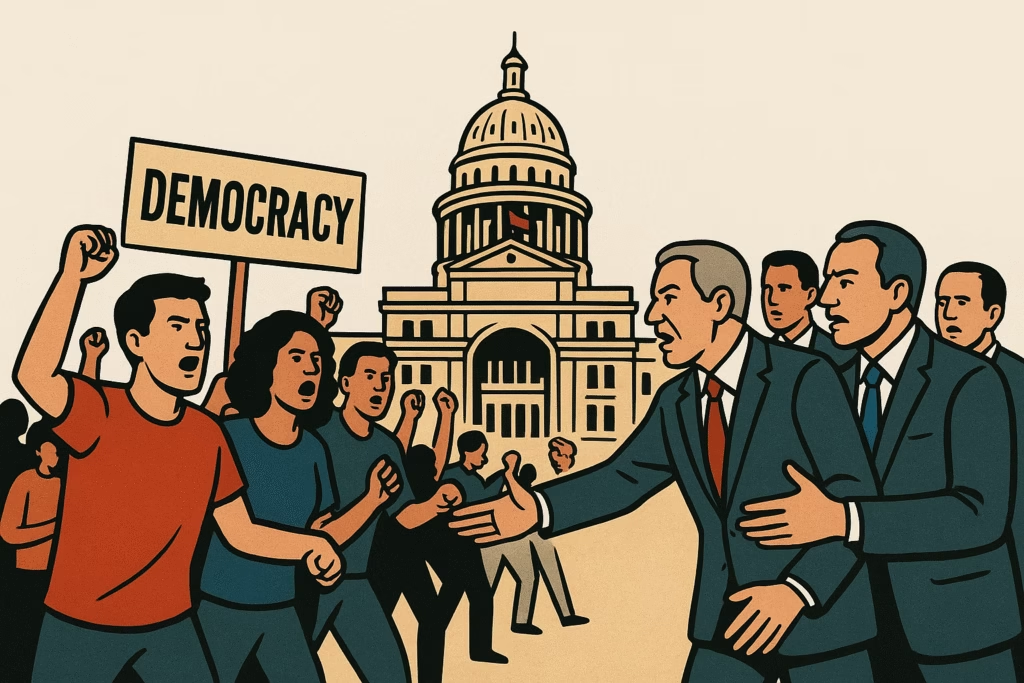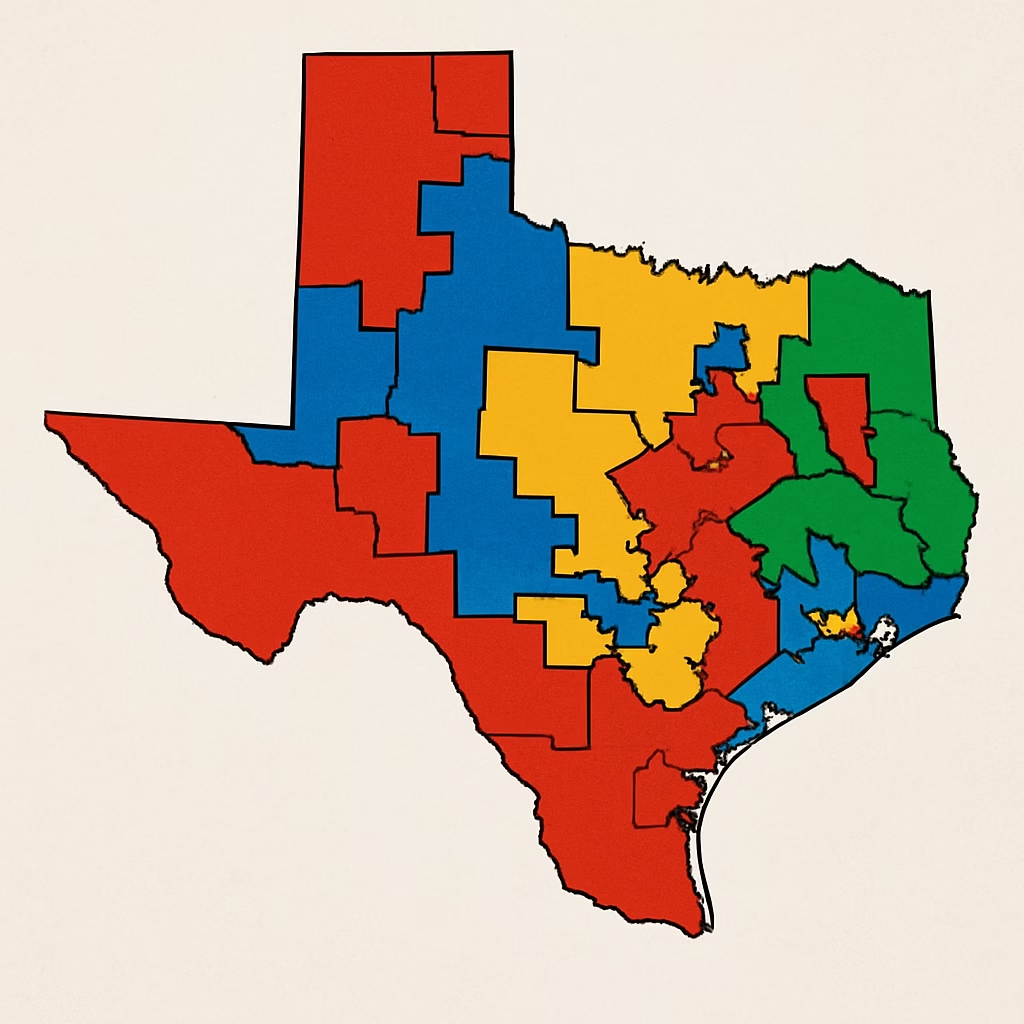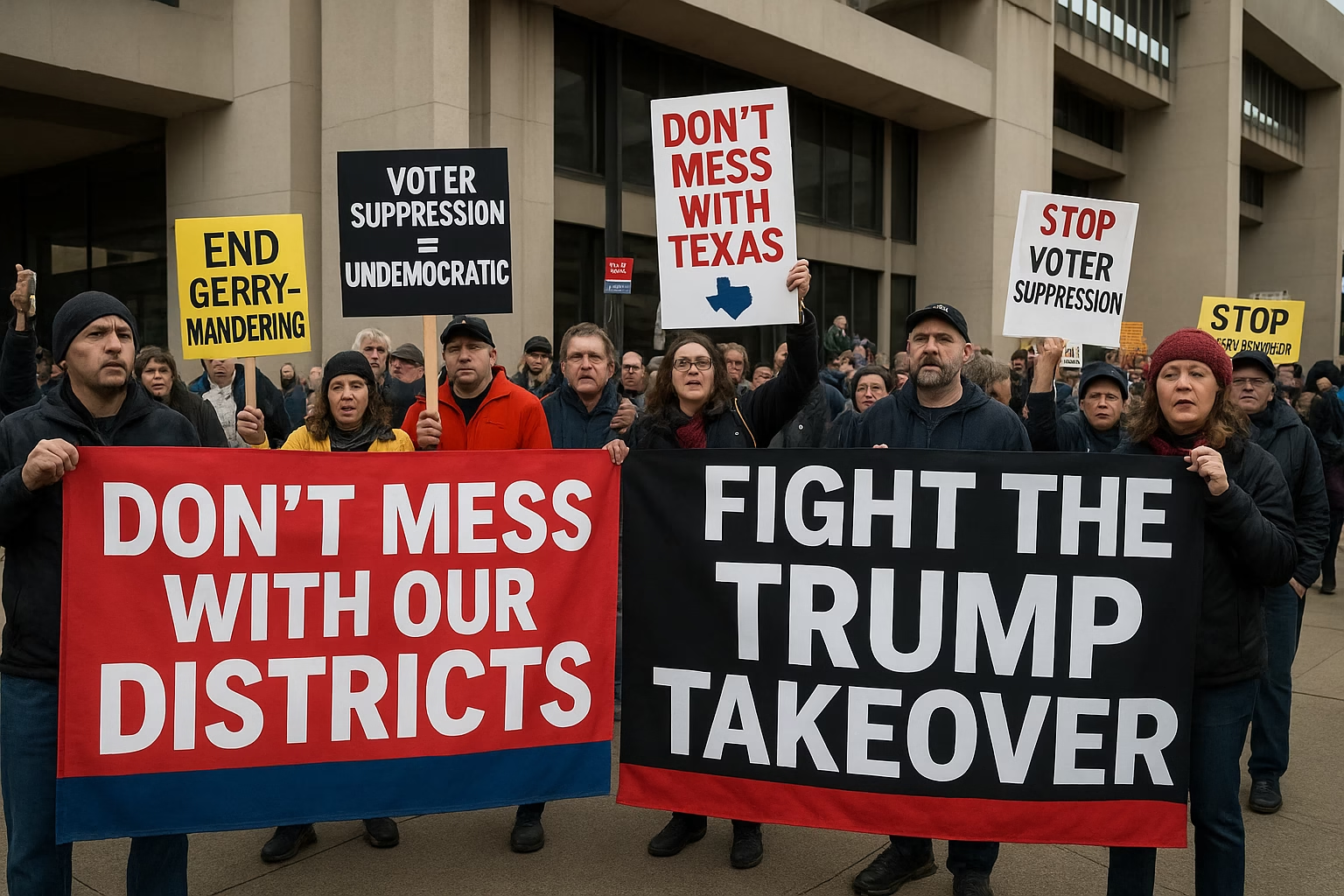Table of Contents
Intro: A New Flashpoint in U.S. Democracy

In recent weeks, Texas has once again become the center of a national political storm. At the heart of the controversy lies an aggressive redistricting plan spearheaded by Texas Republicans, backed by former President Donald Trump, and fiercely opposed by Democrats and activists nationwide. What might appear at first glance as a routine reshaping of congressional districts has quickly escalated into a defining test for American democracy—raising urgent questions about representation, authoritarian overreach, and the very future of free elections.
Protesters across 34 states gathered in nearly 280 rallies under the banner “Fight the Trump Takeover”, signaling that the Texas redistricting battle is not just a local fight but a national concern. This blog dives deep into the history, implications, and growing tensions, while also exploring what these developments mean for the democratic system moving forward.
A Historical Perspective: Redistricting and Power Plays

Redistricting is not new. Every ten years, states redraw their congressional maps following the census. Traditionally, this process is intended to ensure fair representation based on population shifts. However, history shows a darker side: redistricting has often been exploited as a tool for gerrymandering, where ruling parties manipulate district lines to cement political dominance.
What makes the current situation in Texas so alarming is not simply the act of redistricting itself but the timing and motivation behind it. Rather than following the usual cycle, Texas Republicans are moving mid-cycle, creating a narrative of urgency and power consolidation that critics argue undermines the very essence of democracy.
Why This Matters: Beyond Texas Borders
The Texas redistricting push matters for several reasons:
- National Political Impact—The plan could hand Republicans up to five additional congressional seats, significantly altering the balance of power in Washington ahead of the next midterm elections.
- Setting a Dangerous Precedent—Mid-cycle redistricting challenges long-standing norms and opens the door for similar moves in other states, eroding trust in electoral fairness.
- A Wider Pattern of Authoritarian Behavior – The maneuver aligns with broader efforts associated with Donald Trump’s rhetoric and strategies, which critics say seek to normalize anti-democratic practices.
In short, this is not simply a Texas issue; it is a national referendum on how far political leaders are willing to go in bending democratic norms for partisan gain.
Authoritarian Overtones: Trump’s Expanding Overton Window

Former President Donald Trump has consistently challenged democratic norms. From claiming mail-in voting is fraudulent to joking about canceling elections during wartime and even floating the idea of a third presidential term, Trump has pushed the boundaries of what is politically acceptable.
These remarks and actions are not harmless political theater. They expand the “authoritarian Overton window,” gradually normalizing ideas once considered unthinkable. The Texas redistricting plan, pursued at his urging, is part of a broader strategy to reshape not just the political map but also the cultural acceptance of authoritarian-style governance.
Federal Power and Political Intimidation
One of the more alarming trends tied to this new era of politics is the use of federal forces in politically charged ways. Whether through ICE raids, federal policing in opposition-heavy cities, or the deployment of agents at public events, there is growing concern that law enforcement tools are being weaponized for political ends.
This type of state-sponsored intimidation is not typical of democratic governance. Instead, it mirrors tactics used by authoritarian regimes worldwide—where opposition is silenced, protesters are surveilled, and dissent is equated with disloyalty. The U.S., long considered a model democracy, now finds itself navigating this dangerous slippery slope.
Pardoning Insurrectionists: A Green Light for Political Violence
Trump’s decision to pardon all those found guilty of the January 6 Capitol attack may have been the most obvious sign of how much these standards are being undermined. Those who used violence to try to rig an election were essentially absolved by this extraordinary gesture.
In addition to legitimizing political violence, pardons also convey the idea that future acts of rebellion may be accepted—even encouraged. The symbolism here is astounding. Such actions constitute a direct attack on the fundamentals of a democracy that is based on the peaceful transition of power.
Democratic Countermeasures: “Fight Fire with Fire”
Democratic leaders, particularly in California, are responding by taking a more assertive stance. Governor Gavin Newsom has promised to use proactive strategies, including as ballot initiatives and judicial challenges aimed at lessening the consequences of gerrymandering, to offset Republican gains.
This approach marks a turning point. For decades, Democrats often sought to defend norms through institutional restraint. Now, facing what they see as an existential threat, they are embracing a “fight fire with fire” strategy. While risky, this shift reflects the growing recognition that traditional restraint may no longer be sufficient to safeguard democracy.
Election Integrity: A Fragile Safeguard
Despite these troubling trends, there remains cautious optimism about the resilience of American elections. The U.S. electoral system is decentralized, meaning it is managed state by state, rather than under a single national authority. This structure makes it harder for one party to manipulate the entire system.
However, the system is not immune. Localized voter suppression efforts, partisan oversight boards, and mid-cycle redistricting all introduce vulnerabilities. Collectively, these measures chip away at public confidence in elections and raise doubts about whether votes will be counted fairly.
Stress Testing Democracy: The Normalization of Authoritarian Practices
What we are witnessing is a stress test of America’s democratic institutions. Every decision to redraw maps early, deploy federal forces politically, or excuse political violence represents a gradual erosion of democratic norms.
While none of these actions may individually topple democracy, their cumulative effect is powerful. Over time, such practices risk normalizing an authoritarian style of governance in which elections become symbolic rituals rather than true contests of representation.
Implications for the Future
The Texas redistricting battle is more than a fight over lines on a map. It is a signal flare of broader trends:
- The erosion of electoral fairness as a bedrock democratic principle.
- The normalization of authoritarian rhetoric and tactics at the highest levels of politics.
- The polarization of strategies, with both sides increasingly abandoning restraint in favor of raw power plays.
If left unchecked, these trends could reshape the very character of American democracy. The stakes, therefore, extend well beyond 2025’s political calendar—they reach into the nation’s democratic future.
FAQs
Why is Texas redistricting considered so controversial?
Because it is being done mid-cycle, outside the traditional census-based process, and could unfairly advantage Republicans by creating five additional congressional seats.
How does this connect to Donald Trump?
Trump has actively encouraged Republican-led state legislatures to pursue aggressive redistricting and other measures, framing them as necessary to “secure” elections. These acts, according to critics, are consistent with authoritarian tactics.
What role do protests play in this fight?
Protests across 34 states under the “Fight the Trump Takeover” slogan reflect growing national concern. Activists argue that redistricting in Texas represents a national assault on voting rights and representation, not just a state issue.
Could Democrats stop the plan?
Democrats temporarily delayed the vote by leaving the state to break quorum. However, Republicans are expected to push it through once a quorum is reached, making legal challenges and ballot initiatives the likely next battlegrounds.
What does this mean for American democracy?
It underscores a fragile moment where democratic norms are being tested. The long-term concern is that authoritarian-style practices could become normalized if not met with strong resistance.
Conclusion: The Fight for Representation is the Fight for Democracy
The battle over Texas redistricting is not an isolated political skirmish—it is a microcosm of a larger democratic crisis unfolding across the United States. From Trump’s authoritarian rhetoric to unprecedented pardons of insurrectionists, from the weaponization of federal forces to mid-cycle electoral manipulation, the signals are unmistakable: America’s democratic system is under sustained pressure.
Yet the resilience of democracy lies in its people—in the protesters, lawmakers, and citizens who refuse to accept the erosion of their rights. The road ahead may be fraught with polarization and conflict, but history shows that democracy can endure when vigilance meets determination.
The question now is whether Americans are willing to stand up and fight back—because in this moment, the fight for fair maps is the fight for democracy itself.
Discover more from NewsBusters
Subscribe to get the latest posts sent to your email.

2 thoughts on “Democracy Under Siege: The High-Stakes Battle Over Texas Redistricting and America’s Political Future”